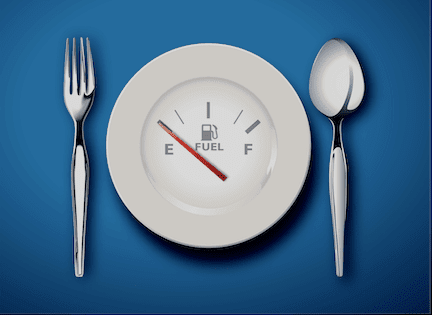[vc_row][vc_column][vc_column_text]
Calories – Hunger to Fullness Scale
Calories are the energy that our body needs to survive. In Part 1, we looked at the chemistry behind calories and talked generally about how many we need to survive. Yet everywhere we look, we see calorie counts and suggested food amounts. Instead of looking at our calorie count as a magical number, if we continue to look at calories as energy, then we can start to figure out just how much fuel or energy we need on a given day.So how do we gauge intake?
If you are concerned about eating too much or too little, it’s best to talk with a registered dietitian to create a personalized plan based on your unique needs. I do not universally recommend tracking food (or calories) in an app, website, or journal because the practice can cause harm if not done with care and a thorough understanding of its role in guiding nutrition goals. Instead, especially for high school students, it’s more valuable to pay attention to signs from your body that you’re giving it enough fuel. Signs you’re not eating enough energy:- Low energy / fatigue
- Difficulty concentrating
- Bloating and/or constipation
- Tired
- Stalled training
- Missed menstrual cycles
- Constantly thinking about food
- Irritability
- Hair loss / brittle nails
- Constantly getting sick
Nutrition is one piece of our fitness journey. See how schools use PLT4M to take a holistic approach to fitness and training.
[/vc_column_text][/vc_column][/vc_row][vc_row][vc_column width=”1/3″][/vc_column][vc_column width=”1/3″][vc_btn title=”Request A Demo” link=”url:https%3A%2F%2Fplt4m.com%2Fwant-to-see-more%2F|title:Want%20to%20See%20More%3F||” el_class=”red_button”][/vc_column][vc_column width=”1/3″][/vc_column][/vc_row][vc_row][vc_column][vc_separator][/vc_column][/vc_row][/vc_section][vc_row][vc_column][vc_video link=”https://youtu.be/De1E3Mi-UTg”][/vc_column][/vc_row][vc_row][vc_column][vc_column_text]WHAT ABOUT TOO MUCH?
Determining whether or not you’re eating MORE energy than what your body needs is a bit trickier. Weight itself is not a great indicator because on any given day, a body can change 5-8 pounds based on water shifts alone – it has nothing to do with weight gain. Instead of focusing on overfueling, I prefer to focus on signs someone might not be eating in a way that makes them feel unsatisfied and, in turn, regularly eat beyond the point of physical need. These include- Going more than 5 hours without eating
- Feeling extremely hungry by the time they eat
- Constantly thinking about food
- Feeling anxious around food
- Rigid food rules (e.g., foods you can eat and foods you cannot)
- Making up for foods you’re “not supposed to have”
- Having “cheat” days
- Feeling out of control around foods
- Eating in front of the tv, phone, computer, books
- Feeling “full” but still wanting more / different food
- Regularly eating to avoid feeling emotions
- Feeling guilt or shame around food










